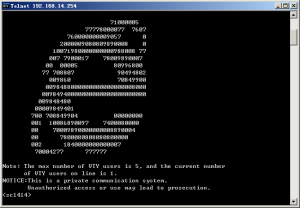我们在串口或者telnet登录设备时,自动打印一些自定义的信息,如不同级别的登录用户名和密码,或者警示非法用户精致登录。
比如:总部的管理员给分支机构的工程师设置一个level 1权限的用户和密码,仅供查看配置,不能更改,但是分支机构的工程师又记不住用户名和密码,这时可以设置一个Hearer login information,当登录时就能看到此用户名和密码。
[Quidway]header shell information % The banner text supports 220 characters max, including the start and the end cha racter.If you want to enter more than this, use banner file instead.Input banner text, and quit with the character '%': ###################### Level 1 user:Demo Password:Demo ###################### % [Quidway] 注意:输完命令header shell information后,需要敲一个特殊字符,什么符号都可以,比如“%”,然后回车进入“shell' information”的输入界面,此时可以随意输入任何字符,最后一定要以“%”结束,然后回车退出此界面,方可生效。
如果输入的信息不需要换行,则直接header shell information %XXX% 一条命名输完回车即可。
设置成功之后,下次登录前就会看到:
User interface con0 is available
Please Press ENTER.
######################
Level 1 user:Demo
Password:Demo
######################
Login authentication
Username:Demo
[Huawei]header ? login Specify the login authentication banner shell Specify the start banner of session Scico(config)#banner ? LINE C banner-text c, where 'c' is a delimiting character exec Set EXEC process creation banner incoming Set incoming terminal line banner login Set login banner motd Set Message of the Day banner

[sc1414]header shell file ?
STRING<5-64> Filename of banner
使用上述命令加载路由器上的TXT文件,(我们可以使用FTP上传到设备上)
我们可以用字符画生成工具生成一些好玩的字符画~
下载
可以吓唬人哈哈